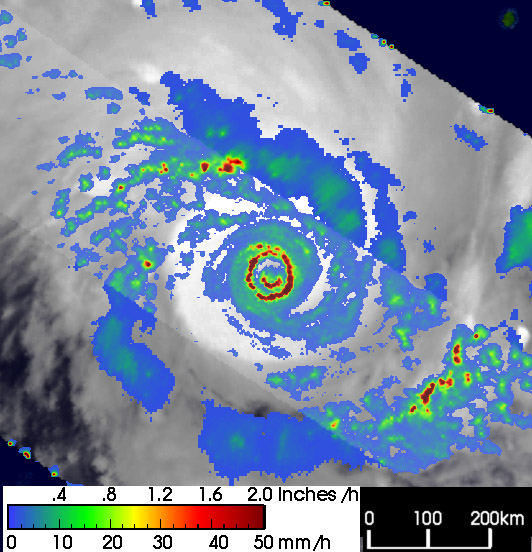File:Heta trmm2004005 lrg.jpg
- Fichier
- Historique du fichier
- Utilisations locales du fichier
- Utilisations du fichier sur d’autres wikis
- Métadonnées
Heta_trmm2004005_lrg.jpg (532 × 552 pixels, taille du fichier : 149 kio, type MIME : image/jpeg)
Légendes
Légendes
Description[modifier]
| DescriptionHeta trmm2004005 lrg.jpg |
Heta meandered northwest of Samoa over the weekend before turning south and passing just west of the islands on Monday, January 5, 2004. Winds up to 105 miles per hour buffeted the islands knocking out power, uprooting trees, and causing extensive roof damage. After passing Samoa, Heta continued southeast and intensified with sustained winds estimated at 133 miles per hour and gusts of up to 185 miles per hour as it was headed for the tiny island nation of Niue. The Tropical Rainfall Measuring Mission (TRMM) satellite captured this impressive image of Cyclone Heta as it was passing just west of Samoa. The image was taken at 6:08 UTC on January 5, 2004. This image shows the horizontal distribution of rain rates as seen from above by the TRMM satellite. Rain rates in the center swath are from the TRMM Precipitation Radar (PR), the first precipitation radar in space, while rain rates in the outer swath are from the TRMM Microwave Imager (TMI). The rain rates are overlaid on infrared (IR) data from the TRMM Visible Infrared Scanner (VIRS). TRMM reveals that Heta has a double eyewall structure, which can sometimes occur in mature, intense tropical cyclones. The outer eyewall, the intense band of heavy, 2-inch-per-hour rain rates shown by the dark red circle completely surrounds a partial inner eyewall shown by the smaller dark red semicircle. Tropical cyclones act as large heat engines. When water vapor condenses into the cloud droplets that form the precipitation, heat, known as latent heat, is released and drives the storm. Generally, the more heat that is released, the more powerful the storm will become. This heating is also most effective near the center of the storm as is the case with Heta. TRMM is a joint mission between NASA and the Japanese space agency NASDA. |
||||||
| Date | |||||||
| Source | http://earthobservatory.nasa.gov/NaturalHazards/shownh.php3?img_id=11897 | ||||||
| Auteur | Image produced by Hal Pierce (SSAI/NASA GSFC) and caption by Steve Lang (SSAI/NASA GSFC) | ||||||
| Autorisation (Réutilisation de ce fichier) |
|
Historique du fichier
Cliquer sur une date et heure pour voir le fichier tel qu'il était à ce moment-là.
| Date et heure | Vignette | Dimensions | Utilisateur | Commentaire | |
|---|---|---|---|---|---|
| actuel | 28 novembre 2006 à 14:35 |  | 532 × 552 (149 kio) | Good kitty (d | contributions) | == Summary == {{Information |Description=Heta meandered northwest of Samoa over the weekend before turning south and passing just west of the islands on Monday, January 5, 2004. Winds up to 105 miles per hour buffeted the islands knocking out power, uproo |
Vous ne pouvez pas remplacer ce fichier.
Utilisations locales du fichier
Aucune page n’utilise ce fichier.
Utilisations du fichier sur d’autres wikis
Les autres wikis suivants utilisent ce fichier :
- Utilisation sur fr.wikipedia.org
- Utilisation sur pl.wikipedia.org
- Utilisation sur pt.wikipedia.org
Métadonnées
Ce fichier contient des informations supplémentaires, probablement ajoutées par l'appareil photo numérique ou le numériseur utilisé pour le créer.
Si le fichier a été modifié depuis son état original, certains détails peuvent ne pas refléter entièrement l'image modifiée.
| Orientation | Normale |
|---|---|
| Résolution horizontale | 72 pt/po |
| Résolution verticale | 72 pt/po |
| Logiciel utilisé | Adobe Photoshop 7.0 |
| Date de modification du fichier | 6 janvier 2004 à 17:36 |
| Espace colorimétrique | Non calibré |


